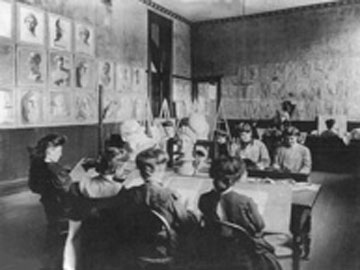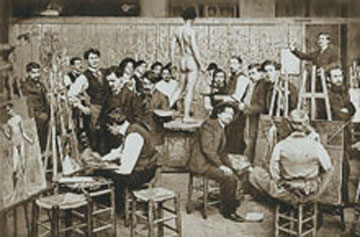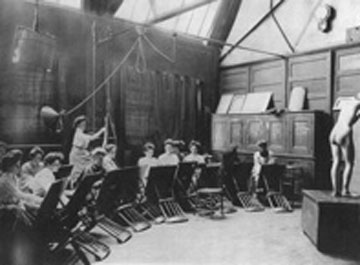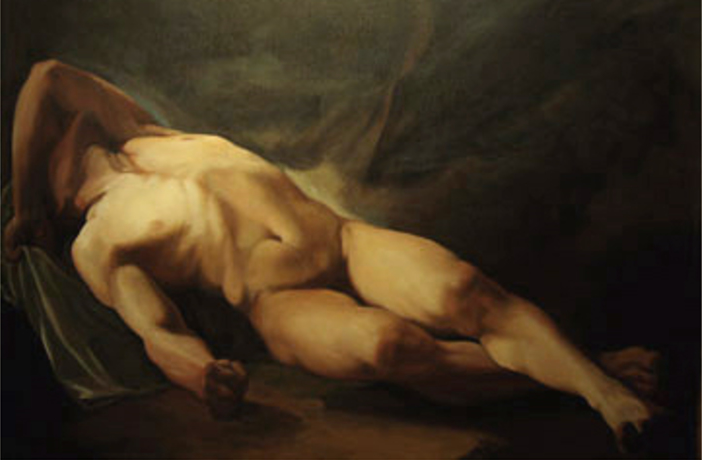
The Academic Method, Classical Art, Realist Art Instruction Today
"As the models from which the students worked were already idealized works of art, they helped to inculcate in the students a mannered vision of nature, which encouraged them to draw the live model in a conventional, idealized and non individual way. Although the anatomical idiosyncrasies of the human figure were a shock to the students' unaccustomed eyes, the tendency to see the form only in abstract line and tonal gradations was already well ingrained. Models were commonly posed in noble stances derived from antique statues, which both aided the transition from cast to live model, and maintained the emphasis on the classical tradition." — Jose Parramón author of The Big Book on Oil Painting.
Traditional Representational Art in Expressionism, Romanticism, Classicism and Naturalism
Representational painters would do well to become familiar with these four philosophies in formal, ahistorical terms. All traditional representational drawing and painting comprises a mixture of each of these approaches in varying degrees, the emphasis within the overall makeup defining the essential character of each particular "school," style or individual artist.
The term "classical" refers to an idealized concept of natural beauty, born in antiquity, revived in the Renaissance and elaborated in the 19th century. In its contrast to a literal bias that describes individual aspects of the subject, classicism interprets naturalistic appearance as it is enveloped and influenced by an artistic concept of a platonic model. The term "romantic" describes interpretations that primarily serve the unique, personal sensibilities of the artist. Yet from a formal academic standpoint, classicism and romanticism, are not that far apart within the push and pull of history, they are essentially part of the same tradition, modulations of a body of conventions for the artistic representation of the natural world. Works with a romantic flavor have, first and foremost, a pictorial character that conjures up the natural world even if distortion or painterly aspects are apt to draw greater attention.
"Expressionism" can be understood as an extension of the romantic impulse. (Historically, the term refers to work that doesn't necessarily conjure up a high degree of natural illusion. As a term, it will often show up in texts referring to 20th century art, along with the tributary term "abstract expressionism".)
On the other side of things, "naturalism" can be understood as an extension of classicism that leans to a greater degree toward the specific, individual aspects of visual truth and less toward the idea of platonic summation, thus veiling down the obviousness of the classical underpinnings it is built upon. (Naturalism, as exemplified by the school of Realism in the 19th century, adhered significantly to classicized visual truth but was distinguished by the choice of more everyday subjects.)
Despite their interpretive differences, all of these categories can be thought of in terms of their relative degree of literalism as abstractions of reality, or for that matter, their relative degree of abstractionism as depictions of natural phenomena. All Western painting is abstract. It is just a matter of the extent to which natural appearances (if any) are conjured up. The terms "abstract expressionism" and "classical realism," like many historical terms, probably do more to confuse than clarify. The former term refers to non-representational work and the term "classical realism" to work at the other end of the scale, the further the distance the greater the literal description.
As artistic endeavor shifts more expressionistically away from its romantic core the issue for the artist is increasing alienation from the appearance of the natural world. Conversely, if artistic work shifts more naturalistically from its classical roots, the artist's problem is over-reliance on the literal truth of appearances and the loss of classical clarity. It should be kept in mind that the ancients themselves who later became known as supreme classicists would have considered themselves naturalists, and that even the naturalists of the 19th century stayed closer to their classical roots than many so-called realists today.
From Romanticism to Abstractionism and from Classicism to Literalism
Following 19th-century Impressionism, works of an even more expressionistic and less academic sort emerged, the first school of which was labeled Post-Impressionism. From a traditional viewpoint, this is where things really started to come unhinged. Impressionism was in fact the last stage in the 500-year evolution of a visual language aimed at creating the illusion of natural appearances. Despite the sense of revolutionary upheaval synonymous with the times, the Impressionists were building on the traditional language they had inherited, a language based on the visual laws of the natural world and certain ideas about how human visual perception functions. Whereas before painters were working primarily with chiaroscuro effects created by studio light, painters now focused on the concept of broken color and directed their efforts to capturing the effects of the outdoors in natural sunlight.
In the wake of Impressionism, artists began consciously to draw more heavily upon their personal inclinations, no longer relying on natural appearances as the guide to their interpretations. Instead, they allowed their creative instincts free play, ostensibly to escape what they considered the stifling constraints of academism based on the preceding classical and naturalist precepts, thus displaying what the more traditionally minded considered a wonton disregard for naturalistic effect.
With Cézanne (who parted ways with the prestigious academy of Bouguereau), we are subjected to the destruction of spatial illusion in favor of "maintaining the integrity of the picture plane." With Matisse (who likewise parted ways with Gérôme), we are taken on a binge of arbitrary color and shape. From the standpoint of traditional representational poetic realism, this is really the birth of modernity in painting. From this point on we may fast forward through Gauguin, Picasso and Kandinsky to the abstract expressionism of Pollock . . . all displaying progressively less interest in the representation of naturalistic appearances and the visual laws pertaining to them. Write-ups on all of these familiar names can be found in just about any book on Western art history, often intermingled with information on more traditional artists. On the other side of the scale, photo-realism, pop art, photography, non-academic-realism and/or realism of a highly literal character (all representational but sharing no common ground with the poetic intent or formal academic standards of traditional painting) are also mentioned within the same historical parameters. This art historical practice tends to reinforce the idea, implied or stated, that there is a largely unbroken continuity between 20th century art and the traditional work that preceded it, rather than highlighting the significant dislocation that occurred in the 20th century following Impressionism.
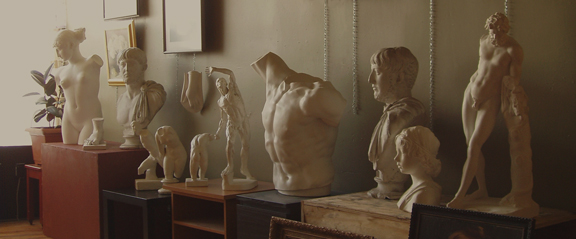
19th Century Academic Practice
The visual language of Western pictorial art that reached its formal zenith in the academies of the 19th century was considerably more formidable and extensive than in most academies today. It was designed to deliver the requisite skills to become a professional representational painter and instructor of the finest kind – a master.
This training was provided in ateliers, that were often no more than naturally lit studios adorned with atelier work and equipped with such basic articles as a modeling stand, easels, work-related reference and, of course, a good collection of plaster casts. Each atelier was headed by a single instructor. Sometimes there were several ateliers in one single academy. For additional information, please see also Wikipedia excerpt on Academic Art below
A Thorough and Comprehensive Process: Work from the Live Model Held off until Sufficient Mastery of the Requisite Preparatory Knowledge had been Attained
A description of 19th century French academic training follows, courtesy of Wikipedia. "Young artists spent years in rigorous training. In France, only students who passed an exam and carried a letter of reference from a noted professor of art were accepted at the academy's school, the Ecole des Beaux-Arts. Drawings and paintings of the nude, called 'academies,' were the basic building blocks of academic art, and the procedure for learning to make them was clearly defined. First, students copied prints after classical sculptures, becoming familiar with the principles of contour, light, and shade. The copy was believed crucial to the academic education; from copying works of past artists, one would assimilate their methods of art-making. To advance to the next step, and every successive one, students presented drawings for evaluation. If approved, they would then draw from plaster casts of famous classical sculptures. Only after acquiring these skills were artists permitted entrance to classes in which a live model posed. Interestingly, painting was not actually taught at the Ecole des Beaux-Arts until after 1863. To learn to paint with a brush, the student first had to demonstrate proficiency in drawing, which was considered the foundation of academic painting. Only then could the pupil join the studio of an academician and learn how to paint. Throughout the entire process, competitions with a predetermined subject and a specific allotted period of time measured each student's progress."
When the Wikipedia entry uses the term "copy", it should be understood that it is entirely possible to copy finished works of art without acquiring a level of understanding equivalent to that represented in the piece being studied. Seeing that some shape is wider and darker doesn't tell the student why that is so. The student may also produce an attractive copy but remain unable to produce a result from life that is equally expressive. The how-to of copying is a very critical area indeed. It is important to explore the why behind the interpreted and organized visual facts along with how to reproduce them.
19th Century Cast Drawing Reflects a Conceptual Difference When Compared to Much of Today's Approach
Students in the 19th century drew from sculpture in a prescribed conceptual and abbreviated manner, helping to train their powers of selection. Elaborated tonal rendering was addressed but not always deemed the most intelligent, productive use of atelier time. Intense drawing practice from the cast with a concentrated reliance on contour and a minimum of tone was emphasized rather than the production of time consuming "finished" cast drawings. Greater emphasis was placed on learning how to make better decisions in these areas, with the goal of instilling a sense of classicized, visual clarity. Naturally lit casts and fine artistic reference were not only used as tools to learn to see shapes and values, but also to convey a comprehensive system of visual clarification that would improve the students' artistic decision-making and serve as a filter through which nature – in all its random vagaries – could be examined, understood and then represented. It is worth noting that in most cases, given the size of the casts and the restraints of floor space, students would have had no choice but to work comparatively rather than sight-size, a proportionate and somewhat elastic framework that allows artistic judgment to manifest itself.
The Use of Natural Light
The use of natural light (preferably from the north) was considered virtually indispensable for the purposes of learning to draw and paint. One really learns to work with natural light rather than from it. Natural light, although more challenging to work with, fosters decision-making capabilities, synchronizing students' artistic thinking with those of their predecessors. Further, natural light consistently offers up form-complementing shadow effects that require more effort and know-how to translate into artistic conclusions. This requires the artist to draw from a well-trained conceptually honed visual memory. The artistic interpretations of the masters were chiefly built upon their knowledgeable appreciation of the beautiful effects produced by natural light. Fuelled lamplight was employed as a last resort only at those times of the day and year when natural light was insufficient.
Tradition and Realism Today
Much of the artistic thinking of traditional masters is absent in the more literal work of today's realists. A great deal of contemporary realism lacks the conceptual foundation and visual unity present in even the most naturalistic work of the 19th century. The understanding and knowledge required to harmonize beautiful proportions and rhythms of the human figure includes many decisions, large and small, that artists from previous generations insisted upon making in their articulations.
Would-be realists need to know that, in fine drawing and painting, there are artistic standards that, when met, alter the way isolated visual facts are organized and translated. These modifications are based on an understanding of the inescapable visual bias of the viewer, the eye as a focusing instrument and the visual solutions that inherently reflect, no matter how naturalistic, the larger, universal truths of representation. As Ingres remarked, "The system is nature."
In contrast, attempting to match values, shapes and hues, piece by piece, leads to results that describe the particular at the expense of the whole. When too much artificial light is employed in the lighting of a subject, the particular itself is also compromised. Effects are copied that will not be in sync with the finished work(s) of art that the student is trying to emulate. Students must learn to concern themselves more about what needs to be seen rather than what is seen. Instruction in selectivity, interpretation and orchestration should not be omitted in favor of repeating exercises that are of limited value for the beginner. The study of morphological design, rhythm, interpretive distortion (including artistic proportion), composition of line and mass, perspective and treatment are central and should be imparted at the earliest possible time.
Great art results when noble sentiment joins forces with a highly trained visual memory derived from the study of great art. It seems, though, that a different straightforward kind of realism is becoming entrenched. It relies less on the art of the past than on quilting together isolated visual facts, concerning itself excessively with nature's random particulars. Painting is more about the symphonic interplay of contrasting visual energies than making things look "real." Although the internal mantra of beginners and masters alike is "Get it right," it must be remembered that "right" is by no means, limited to external visual facts, but also includes the artist's concept and aesthetic. Despite a great deal of effort and time spent learning how to copy fine artistic source material accurately, ultimately, traditional realism as an art form is closely related to music and dance.
A significant part of learning the how-to of art is learning to appreciate and understand traditional art itself. To follow in the masters' footsteps and strive for greater artfulness, students need to learn what they wish to convey about the subject, and this should be based on both a careful study of nature and of the best work of those who have preceded us.
